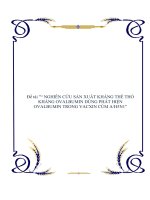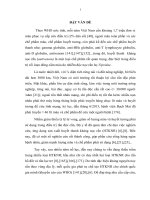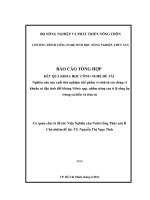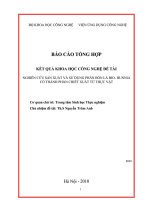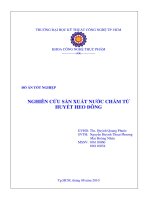nghiên cứu sản xuất huyết thanh kháng nọc rắn cạp nia đa giá f(ab’)2 từ huyết tương ngựa; đánh giá chất lượng chế phẩm trong phòng thí nghiệm bản tóm tắt tiếng anh
Bạn đang xem bản rút gọn của tài liệu. Xem và tải ngay bản đầy đủ của tài liệu tại đây (306.92 KB, 31 trang )
1
INTRODUCTION
1. Why choose topics:
According to WHO estimates, each year Vietnam needs about 1.7 million units of blood for emergency
treatment services (≈ 2% of the population) [40], apart from blood and blood products, plasma products, and
to included serum preparations such as gamma globulin, globulin anti-HBs, anti-T-lymphocyte globulin,
antivenom [141],[147],[152] in which antivenom is very important, especially in the treatment of
hemostatic coagulation disorders due to snake venom poisoning (Vipridae).
As a tropical country, with three-quarters of mountain forests and agricultural lands, over 3000 km long
coastline, Vietnam has a very favorable environment for the development of poisonous snakes. Most
residents living and working in the agricultural environment, forests, islands the risk of poisonous snake
bites are very high (> 30,000 / year [21]); outside the deaths, costs treatment is expensive: many victims
ventilation monthly or tens of liters of blood transfusions and plasma to save lives; records, beginning 6/2013
Bach Mai hospital was ≈ 46 liters of blood transfusion and preparations for saving a patient [174].
To reduce mortality, reduce the number of blood and plasma used to treat poisonous snake bites,
Ministry of Health was interested in directing the research, production applications snake venom serum
antibodies[6],[8]. To date, there have been some very successful research, contributing to save the lives of
2
thousands of patients, significantly reduced blood flow and preparations to use [6],[21]
However, after many years of effort, to date we are still severely lacking in many types of antivenom;
almost like we have only two types of land for cobra and viper bamboo [8],[165],[166],[171]. Due to the
specificity of snake venom antigens geographically, each country must make antivenom for yourself (WHO)
[141],[20],[6]. To meet emergency needs, treating poisonous snake bites, so we need to promote research,
production xuatantivenom; HTKNR especially for dangerous venomous snakes, common, in that species,
leading to nia mention solid waistband, accounting for 35.8% of their poisonous copperhead snakes Elapidae
in Vietnam, the poisonous snakes have extremely strong toxicity, causing very high mortality (> 80% if it is
not an emergency timely treatment) [14].
Actual treatment in Vietnam so far show that have common Bungarus, mainly Bungrarus candidus and
Bungarus multicinctus. These two snake -shaped "piece of black, white songs" are very similar, it is difficult
to distinguish glance. Two different species of snake venom toxicity and the clinical manifestations,
diagnosis is very easy to confuse, antivenom monospecific not work and there is no VDK to confirm the
diagnosis [15]. Research antivenom production rates for both multi- poisonous snakes are dangerous
aforementioned favorable solution provides for the emergency treatment of patients with snake bite in the
country. To increase the safety of antivenom, form F(ab')2 is optimal. At the same time, the complete
production process, standardized products will bring many advantages for the emergency treatment of
3
patients in both North and South as well as in the country.
2. Goals topics:
(1) Production research antivenom resistance (BC + BM) polyclonal F(ab')2 Vietnam meet standards
(Vietnam Pharmacopoeia) from horse plasma.
(2) Evaluate the quality in laboratory.
3. The Significance of topics and new contributions:
3.1. For the first time in Vietnam and around the world has produced BC & BM antivenom against two
common species BC & BM snake , the most dangerous in the Vietnam and on the world.
3.2. The first time was perfect and standardize all stages of the production process BC&BM antivenom, the
end result is a product achieve the National Standards (Vietnam Pharmacopoeia IV, 2009 - latest). Product
was 9/10 basic indicators of quality of WHO.
3.3. Has produced and purified as successful antivenom F(ab') 2 is as preparations advanced, most effective
products in the form of antivenom; remove the Fc of IgG molecules, to the root of the problem
immunological safety of products using the treatment.
3.4. The problem of effective antivenom preparations: has been successfully solved with the synchronous
4
solution: choosing the right type of snake, quality venom , venom lose virulence but retains antigen; make
sure schedules immune adjuvant & antigen dose; follow-up care for horses born best antibody, antibody
plasma high titer; antibody specific, ensuring sterile blood; F(ab')2 biological activity, purification of F(ab')2
has the highest concentration
4. The layout of the thesis:
- Introduction
- Chapter 1: Overview (page 38).
- Chapter 2: Subjects and Methods (18 pages).
- Chapter 3: Research results (31 pages).
- Chapter 4: Discussion (37 pages).
- Conclusions
The thesis is: 128 pages, 29 tables, 4 charts and diagrams, 63 photographs and drawings (48 photos annex),
175 references (40 Vietnamese, English 114, 21 sites), 4 appendices.
Chapter 1: OVERVIEW
1.1. Blood and plasma
1.2. The preparations of blood and plasma products
5
1.3. Extraction of plasma components
1.4. Serum anti-snake venom
1.5. By BC, BM accident and production BC+BM antivenom.
Chapter 2: SUBJECTS & METHODS
2.1. Object & study material:
Studies on laboratory animals: snake, horses, rabbits, guinea pigs, white mice. Materials : venom of BC
& BM: 3.1 g.
2.2. Research Methodology:
2.2.1. Study design: laboratory and experiments on animals.
2.2.2. Product quality standards to be achieved:
Table 2.1: National Standards, Vietnam Pharmacopoeia IV, 2009
Num The target Standard to be achieved
1 General safety Satisfactory
2 Sterility no bacteria, fungi
3 Pyrogen no pyrogen
6
4 Antibody titer / vial > 100 LD50/lọ (5ml)
5 pH 6 - 7
6 Merthiolat ≤ 0,01%
7 Sodium chlorid 0,85 % - 0,9%
8 Total nitrogen ≤ 15 %
Table 2.2: Criteria to achieve the WHO-Guidelines, 2008[151].
Num The target Standard to be achieved
1 General safety Satisfactory
2 Sterility no bacteria, fungi
3 Pyrogen no pyrogen
4 Antibody titer / vial Registration standards
5 pH 6 – 7
7
6
Matter content
preservation
Phenol < 2,5 g/l
Cresols < 3,5 g/l
7 Sodium chlorid 0,85 % - 0,9%
8 Total nitrogen ≤ 100 g/l
9 Albumin ≤ 1 %
10 Globulin > 90%
2.2.3. Research content:
2.2.3.1. Research BC&BM antivenom produced polyclonal F(ab')
2
- Production of antigens .
- Causing susceptible horses, antibody track specific form.
- Take blood, plasma collection, transfer payment RBC.
- Refined BC&BM polyvalent F (ab '
) 2
antivenom, determine the degree of purity of the product.
2.2.3.2. Assessing the quality of BC&BM polyvalent F(ab'
)
2:
8
- Inspection of facilities, assess the safety and efficacy of products.
- Inspection of National, safety assessment, effect, physical and chemical characteristics.
- Preliminary production costing, evaluation of economic efficiency and social.
2.2.4 . The method of research techniques :
- Selection of snakes, venom , venom preserved by the method of Tran Kien, Trinh Xuan Kiem, David
Warell [21],[24].
- Production of antigens and quality evaluation method of Trinh Xuan Kiem and recommended by WHO &
Vietnam Pharmacopoeia.
- Causing susceptible horses, track -specific antibody formation in Ouchterlony tests and serum immune
electrophoresis with venom .
- Collect plasma plasmaferesis method .
- Refined BM+BC antivenom F(ab')
2
by the method of cutting Fc
γ
-globulin by pepsin, precipitated with
ammonium sulphate segments , dialysis with distilled water, filtered Seize. Inspection of facilities: evaluation
of general safety test, heat release factor, bacterial culture, fungal culture, and titer determination LD
50
,
ED
50
.
- After the quality inspection facilities, jarred 5ml/vial sterile and National accreditation requirements .
9
- After the test results National conducted to compare test results to determine the basis of the existing
problems and decide on further processing of batches produced (BC+BM) antivenom. Testing facilities
include: general safety test, test pyrogenic, sterility tests, test its effectiveness. Testing the efficacy of two
steps: determination of LD
50
venom, then determine ED
50
of antiveom has produced. LD
50
calculated by the
formula Karber.
- National Accreditation: the process of National Institute for vaccines and biologicals, including(8): General
safety trials, Sterility testing, Experimental heat release elements, Testing the efficiency (cost efficiency),
Total protein concentration, pH, NaCl concentration. The concentration of the preservative (Merthiolat).
2.3.5. Time and place of study:
- Study period: 6/2008 - 11/2011.
- Location conduct: Research unit antivenom of National Poison control center Bach Mai hospital, National
Institute for Control of vaccines and biologicals (Ministry of Health), Center for Empirical research picnic
Military Medical university, Natioal Institute of hematology and blood transfution , 103 Hospital, Bach Mai
Hospital and several locations in the Hanoi, Vung Tau.
Chapter 3: RESULTS
10
3.1. PRODUCTION POLYVALENT ANTIVENOM F(ab)2 FOR B. CANDIDUS & B.
MULTICINCTUS SNAKE
3.1.1. Antigen fabrication and evaluation of antigen.
Table 3.1: Results snake selected and venom.
Activity & the
snake venom
Bungarus multicinctus Bungarus candidus
snake venom
(gam)
SLNTB
(mg)
snake venom
(gam)
SLNTB
(mg)
activity 1(114) 84 0,5 5,9 30 0,3 10
- 2 (185)
130 0,6 4,6 55 0,5 9,0
- 3 (122)
62 0,5 8,0 60 0,7 11,6
Total (421) 276 1,6 5,79 145 1,5 10,3
SLNTB: average number venom of a snake / times
Table 3.2: Preliminary evaluation of the level of spending Bungarus snake common in Vietnam
Species Bungarus Bungarus Bungarus Bungarus Bungarus
11
Region
fasciatus candidus
multicinctu
s
slowinskii flaviceps
North VN (++) (-) (+++) (-) (-)
South VN (+) (+++) (-) (-) (-)
Note: Not met:(-); Meet but very little number: (+)
Frequent, small amounts (+ +); common, more number: (+ + +)
Table 3.3: The volume of venom antigens and detoxified
Category
Antigen
Antigen volum /vial (ml)
0,1 0,3 0,5 1 2 3 4 5 6
12 12 12 22 12 12 12 12 12
12
Number vial
Number mg
venom/vial ≈
1,1 3,3 5,5 11 22 33 44 55 66
Volum antigen (ml )
∑ = 272,8 ml
1,2 3,6 6 22 24 36 48 60 72
Table 3.4: Safety test with antigen
Mouse
Cobaye
Weight
(g)
Vol.
antigen
(ml)
venom
(mg)
Abnormal Change
Increase
in weight
(g)fever
Loss
hair
weight
(g)
1 230 2,30 25,3 0 0 240 10
2 235 2,35 25,8 0 0 250 15
3 250 2,50 27.5 0 0 260 10
13
4 (chứng) 245 0,0 0 0 0 255 10
Table 3.5: Pyrogen test with antigen
Rabit
weight
(kg)
Vol. Ag
(ml)
venom
(mg)
Temperature before / after
injection Antigen(
o
C)
change
temperature
highest
Start 1 Hour 2 Hour 3 Hour
1 2,1 2,1 23,1 38,5 38,9 39,0 38,5 0,5
o
C
2
2, 3 2,3 25,3 39,1 39,8 39,2 39,1 0,7
o
C
3
2,2 2,2 24,2 39,3 39,5 39,8 39,3 0,5
o
C
Table 3.6. Results bacterial culture, fungal culture for Antigen
Environment Sabouraud (37
o
C) Thioglycolate (20-25
o
C)
14
3
day
7
day
14
day
1
day
2
day
3
day
negative negative negative negative negative negative
3.1.2. Results sensitizer horse & monitor the immune response:
Table 3.7: The dose of antigen and adjuvant sensitizer horse.
Group
Dose
1 2 3 4 5 6 7 8 9
Antigen (ml) 0,1 0,3 0,5 1,0 2,0 3,0 4,0 5,0 6,0
adjuvant CFA (ml) 0,1 0,3 0,5 0 0 0 0 0 0
adjuvant IFA (ml) 0 0 0 1,0 2,0 3,0 4,0 5,0 6,0
Ag + adjuvant (ml) 0,2 0,6 1 2 4 6 8 10 12
Sites 1 3 5 2 4 6 8 10 12
Table 3.8: Change after horse health sensitizer
15
Num
Horse 1 Horse 2
The whole body
in place
The whole body
in
place
Mov
respirati
on
digestion
Mov
respiration digestion
1
weak
Nom Not eat ulcers
weak
Nom Not eat ulcer
2
weak
Nom Not eat ulcers
weak
Nom Not eat ulcer
3
weak
Nom Eat les ulcers
weak
Nom Eat les ulcer
4 Nom Nom Nom Nom Nom Nom Nom Nom
5 Nom Nom Nom Nom Nom Nom Nom Nom
6 Nom Nom Nom Nom Nom Nom Nom Nom
7 Nom Nom Nom Nom Nom Nom Nom Nom
8 Nom Nom Nom Nom Nom Nom Nom Nom
9 Nom Nom Nom Nom Nom Nom Nom Nom
Table 3.9: Antibody titer after immune horses
Time Antibody titer
1 2 3 4 5 6 7 8 9
16
Horse
Hor 1 1/8 1/16 1/32
1/64
1/128 1/256 1/512 1/2048 1/2048
Hor 2
1/8 1/32 1/64
1/128
1/256 1/512 1/1024 1/2048 1/2048
Photo 3.4. Traces of the Ag-Ab 1.5% agarose agar (arrow left)
Photo 3.5. Identify specific antigen with BM+BC Ab by immune electrophoresis (right).
3.1.3. Collect blood, separating plasma, erythrocyte volume:
Table 3.10: The volume of blood, plasma, RBC mass is obtained.
17
Volum
Horse
Blood
(lit) Plasma (lit)
Erythrocyte
volume (lit)
Horse 1
(VP)
Time 1 3,6 2,2 1,4
Time 2 5,1 3,1 2,0
Horse 2
(TP)
Time 1 2,3 1,4 0,9
Time 2 5,5 3,3 2,2
Total 16,5 10,0 6,5
Table 3:11: The amount of blood taken and the horse's reactions
Blood volum
(lit)
Expression of horses
Normal Light shock Shock
Horse 1
Time 1 3,6
X X
Time 2 5,1
X X
Horse 2
Time 1 2,3
X
Time 2 5,5
X X X
3.1.4. Results purified BC+BM polyvalent antivenom F (ab')2:
18
3.1.4.1. Cut Fc, precipitated protein was not antivenom with 14% ammonium sulphate, filtered precipitate more
F (ab ')2:
Table 3.12: The volume of the filtrate with F (ab ') 2 obtained.
target
Parcel
Plasma (ml) The filtrate is Ab
(ml)
Rate filtrate/
Plassma(%)
Parcel 1 3600 2900 80,6%
Parcel 2 6400 5140 80,3%
Total : 10.000 8040 80,4%
3.1.4.2. Precipitated F (ab ') 2 with 22% ammonium sulphate, filtration Whatman filter paper obtained by
precipitation, dialysis, and sterile filtration generated antivenom.
Table 3:13: Precipitation amount of F (ab') 2 obtained.
target
Parcel
The filtrate is F(ab’)2
(ml)
precipitation has F (ab ') 2
obtained (gam)
Parcel 1 2900 210
Parcel 2 5140 395
Total 8040 605
19
Table 3.14. Dialysis fluid & antivenom semi product
Chỉ số NC
Parcel
Dialysis fluid
(ml)
Semi -antivenom
(ml)
Dialysis fluid
lossing (ml)
Parcel 1
190
165
25 (13,1%)
Parcel 2
510
485
25 (5,2%)
Total
700
650
50 (7,7%)
Table 3:15: Number of antivenom F (ab')2 was produced
Product Unit Volum (ml) Number (vial)
Semi – BC+BM antivenom Bottle 500 ml 650 2
Polyvalent antivenom F(ab’)2 Vial 5 ml 650 130
3.1.4.3. Determination of purity of Polyvalent antivenom F(ab’)2
Table 3:17: Quantification of protein, albumin, globulin, IgG, IgM, ratio A/G horse serum and polyvalen
antivenom F (ab')2 of BM&BC
Test Horse antivenom F (ab')2 of BM&BC
20
serum Number Rate
Protein (g/l) 87,1 49,8 100 %
Albumin (g/l) 28,7 1,4 2,8 %
Globulin (g/l) 58,4 48,4
100% 97,2 %
IgG (mg/dl) 865 203
2,141 g/l
≈ 4,4%
IgM (mg/dl) 67,8 8,6
IgA (mg/dl) 6,3 2,5
Tỷ lệ A/G 0,49 0,03
Figure 3.6. Compare pictures horse serum protein electrophoresis (1) (left) and BC+BM antivenomF (ab')2-
21
finished products (2) (Right):
3.2. QUALITY ASSESSMENT OF LABO PREPARATION:
3.2.1. Quality control at the facility:
Table 3:18: Safety testing of antivenom in the guinea pig
Num
Volum
(gam)
AV (ml)
Guinea pig
Increase
in weight
(gam)
Loss
hair
Volum
Week 1 Week 2 Week 3
1 310 3,1 0 320 325 340 +30
2 330 3,3 0 343 350 355 +25
3 350 3,5 0 358 363 370 +20
Table 3:19: Identify pyrogenic in semi-finished products
Num
Volum (kg) Vol
antivenom
Temperature before / after injection
antivenom (
o
C)
Nhiệt độ
chênh lệch
22
(ml) (
o
C)Trước Sau 1 h Sau 2 h Sau 3 h
1 2,8 2,8 39,3 39,6 39,8 39,3 + 0,5
2 2,8 2,8 39,4 39,7 39,8 39,4 + 0,4
3 3,0 3,0 39,6 39,8 39,9 39,6 + 0,3
Table 3:20: Check the level of sterile products
Parcel
Sabouraud (37
o
C) Thioglycolate (20-25
o
C)
Day 3 Day 7 Day 14 Day 3 Day 5 Day 7
Parcel I
negative negative negative negative negative negative
Pảcel II
negative negative negative negative negative negative
Table 3:21: Determination of lethal dose 50% of BC+BM venom
Number
Venom
(µg/ml)
venom/
Swiss mice
(µg)
Swiss mice
rate
(%)
dead live total
23
1 22,50 4,5 8 0 8 100,00
2 15,00 3,00 7 1 8 87,50
3 10,00 2,00 4 4 8 50,00
4 6,66 1,33 1 7 8 12,50
5 4,44 0,88 0 8 8 0,00
6 0 0 0 8 8 0,00
Table 3.22: Determination of effect of antivenom serum
Num
Antivenom
(ml)
BPS
venom 40
LD50(ml)
LD50/
mice
mice
dead live total
1 0.000 2.000 0.000 0 0 8 8
2 0.000 1.000 1.000 4 8 0 8
3 0.060 0.940 1.000 4 6 2 8
4 0.070 0.930 1.000 4 4 4 8
24
5 0.080 0.920 1.000 4 0 8 8
3.2.2. National test results for quality:
Table 3:23: Results of national tests for quality of product
Target Testing
Result
1 Safety test Satisfactory
2 Pyrogen test Satisfactory
3 Sterile test Satisfactory
4 Titer test 267,5 LD
50
/lọ
5 NaCl 0,87%
6 pH 7.012
7 Protein 7,43 mg/ml
8 Merthiolate content 0 g%
Chapter 4: DISCUSSION
25
4.1. PRODUCTION RESEARCH ANTIVENOM F (ab')2 FOR B.CANDIDUS & B.MULTICINCTUS
MEET STANDARDS:
4.1.1. Production of antigens:
- Selection of snakes, their venom: solid selection, their venom is a very important first step of the
production process. 2 species of snake venom intended has made antivenom-cost good quality, representing
the populations of both species in Vietnam. After 6 times conducted collectors get enough of the necessary
venom 2 species north and south. BM&BC sting less, difficult to obtain and very dangerous (Table 3.1).
- Identify common types of solid bay in Vietnam: Vietnam has many compartments snakes "black song,
blanks", easily confused with each other (Table 3.2) is B. candidus, B. multicinctus and Red River snake (B.
slowinskii), in which is 2 common species, have the most number of natural, necessary for producing
antivenom treatment, other less common species.
- Results fabrication BC+BM venom antigen polyclonal, attenuated:
Using 3 g of pure venom of the 2 species, are made 272.8 ml of antigen attenuated. Dividing the number of
antigens of different types of volume based on immune dose schedule and is expected to study the horse's
weight. Close the vial in each group can build from 0.1 ml to 6 ml, divided into 9 steps to 9 months sensitizer
for horses. The number of antigen used to produce enough in research, horses die situation room, study and


